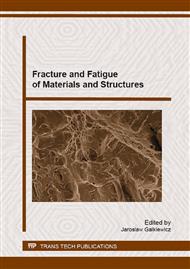[1]
A.L. Gurson, Continuum theory of ductile rupture by void nucleation and growth: Part I – Yield criteria and flow rules for porous ductile media, Journal of Engineering Materials and Technology, 99 (1977) 2–15.
DOI: 10.1115/1.3443401
Google Scholar
[2]
V. Tvergaard, Influence of voids on shear band instabilities under plane strain conditions, International Journal of Fracture, 17 (1981) 389–407.
DOI: 10.1007/bf00036191
Google Scholar
[3]
V. Tvergaard, A. Needleman, Analysis of the cup-cone fracture in a round tensile bar, Acta Metallurgica, 32 (1984) 157–169.
DOI: 10.1016/0001-6160(84)90213-x
Google Scholar
[4]
P. Nègre, D. Steglich, W. Brocks, Crack extension in aluminium welds: a numerical approach using the Gurson–Tvergaard–Needleman model. Engineering Fracture Mechanics, 71 (2004) 2365–2383.
DOI: 10.1016/j.engfracmech.2004.01.007
Google Scholar
[5]
S. Acharyya, S. Dhar, A complete GTN model for prediction of ductile failure of pipe. Journal of Materials Science, 43 (2008) 1897–(1909).
DOI: 10.1007/s10853-007-2369-0
Google Scholar
[6]
M. Abbasi, M. A. Shafaat, M. Ketabchi, D. F. Haghshenas, M. Abbasi, Application of the GTN model to predict the forming limit diagram of IF-Steel. Journal of Mechanical Science and Technology, 26 (2012) 345–352.
DOI: 10.1007/s12206-011-1038-z
Google Scholar
[7]
P.G. Kossakowski, Fatigue strength of an over one hundred year old railway bridge, The Baltic Journal of Road and Bridge Engineering, 8 (2013) 166–173.
DOI: 10.3846/bjrbe.2013.21
Google Scholar
[8]
P. Kossakowski, Numeryczna analiza rozwoju mikrouszkodzeń w elemencie z defektem w postaci nieciągłości strukturalnej, Budownictwo i Architektura, 12 (2013) 235–242.
Google Scholar
[9]
P. G. Kossakowski, Simulation of ductile fracture of S235JR steel using computational cells with microstructurally-based length scales, Journal of Theoretical and Applied Mechanics, 50 (2012) 589–607.
Google Scholar
[10]
P. G. Kossakowski, An analysis of the load-carrying capacity of elements subjected to complex stress states with a focus on the microstructural failure, Archives of Civil and Mechanical Engineering, 10 (2010) 15–39.
DOI: 10.1016/s1644-9665(12)60048-x
Google Scholar
[11]
I. R. Dzioba, Properties of 13KhMF steel after operation and degradation under the laboratory conditions, Materials Science, 46 (2010) 357–364.
DOI: 10.1007/s11003-010-9297-x
Google Scholar
[12]
P. G. Kossakowski, An analysis of the Tvergaard parameters at low initial stress triaxiality for S235JR steel, Polish Maritime Research, 21 (2014) 100–107.
DOI: 10.2478/pomr-2014-0046
Google Scholar
[13]
P. G. Kossakowski, W. Wciślik, Experimental determination and application of critical void volume fraction fc for S235JR steel subjected to multi-axial stress state, in: T. Łodygowski, J. Rakowski, P. Litewka (Eds. ), Recent Advances in Computational Mechanics, CRC Press/Balkema, London, 2014, p.303.
DOI: 10.1201/b16513-39
Google Scholar
[14]
P. G. Kossakowski, W. Wciślik, Effect of critical void volume fraction fF on results of ductile fracture simulation for S235JR steel under multi-axial stress states, Key Engineering Materials – Fracture and Fatigue of Materials and Structures, 598 (2014).
DOI: 10.4028/www.scientific.net/kem.598.113
Google Scholar
[15]
P.G. Kossakowski, Stress Modified Critical Strain criterion for S235JR steel at low initial stress triaxiality, Journal of Theoretical and Applied Mechanics, 52 (2014) 995–1006.
DOI: 10.15632/jtam-pl.52.4.995
Google Scholar
[16]
W. Wciślik, Numerical determination of critical void nucleation strain in the Gurson-Tvergaard-Needleman porous material model for low stress state triaxiality ratio, in: METAL 2014 23rd International Conference on Metallurgy and Materials, TANGER Ltd., Brno, 2014, p.794.
Google Scholar
[17]
P.G. Kossakowski, Microstructural failure criteria for S235JR steel subjected to spatial stress states, Archives of Civil and Mechanical Engineering, 15 (2015) 195–205.
DOI: 10.1016/j.acme.2014.02.008
Google Scholar
[18]
Abaqus 6. 10. Analysis User's Manual, Dassault Systèmes, Providence (2010).
Google Scholar


